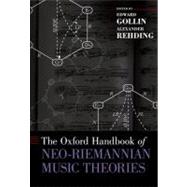
The Oxford Handbook of Neo-Riemannian Music Theories
by Gollin, Edward; Rehding, AlexanderBuy New
Rent Textbook
Rent Digital
Used Textbook
We're Sorry
Sold Out
How Marketplace Works:
- This item is offered by an independent seller and not shipped from our warehouse
- Item details like edition and cover design may differ from our description; see seller's comments before ordering.
- Sellers much confirm and ship within two business days; otherwise, the order will be cancelled and refunded.
- Marketplace purchases cannot be returned to eCampus.com. Contact the seller directly for inquiries; if no response within two days, contact customer service.
- Additional shipping costs apply to Marketplace purchases. Review shipping costs at checkout.
Summary
Author Biography
Edward Gollin is Associate Professor of Music at Williams College.
Alexander Rehding teaches music at Harvard University. His interests are in the history of music theory, and in nineteenth and twentieth century music. He is the author of Hugo Riemann and the Birth of Modern Musical Thought and Music and Monumentality, and is co-editor of Acta musicologica.
Table of Contents
| Acknowledgments | p. vii |
| Preface | p. ix |
| Contributors | p. xvii |
| Intellectual Contexts | |
| The Reception of Hugo Riemann's Music Theory | p. 3 |
| "The Nature of Harmony": A Translation and Commentary | p. 55 |
| What Is a Function? | p. 92 |
| Riemann and Melodic Analysis: Studies in Folk-Musical Tonality | p. 140 |
| Dualism | |
| The Problem of Harmonic Dualism: A Translation and Commentary | p. 167 |
| Harmonic Dualism as Historical and Structural Imperative | p. 194 |
| Dualistic Forms | p. 218 |
| Dualism and the Beholder's Eye: Inversional Symmetry in Chromatic Tonal Music | p. 246 |
| Tone Space | |
| From Matrix to Map: Tonbestimmung, the Tonnetz, and Riemann's Combinatorial Conception of Interval | p. 271 |
| On the Imagination of Tone in Schubert's Liedesend (D473), Trost (D523), and Gretchens Bitte (D564) | p. 294 |
| Tonal Pitch Space and the (Neo-)Riemannian Tonnetz | p. 322 |
| Harmonic Space | |
| Neo-Riemannian Perspectives on the Harmonieschritte, with a Translation of Riemann's Systematik der Harmonieschritte | p. 351 |
| On a Transformational Curiosity in Riemann's Schematisirung der Dissonanzen | p. 382 |
| Chromaticism and the Question of Tonality | p. 400 |
| Temporal Space | |
| Criteria for Analysis: Perspectives on Riemann's Mature Theory of Meter | p. 419 |
| Reading between the Lines: Hugo Riemann and Beethoven's Op. | p. 31 |
| Metric Freedoms in Brahms's Songs: A Translation and Commentary | p. 462 |
| Transformation, Analysis, Criticism | |
| Riemannian Analytical Values, Paleo- and Neo- | p. 487 |
| Tonal Interpretation, Transformational Models, and the Chromatic Calls to Repent in Franck's Le chasseur maudit | p. 512 |
| Three Short Essays on Neo-Riemannian Theory | p. 548 |
| Glossary | p. 579 |
| Selected Bibliography | p. 583 |
| Index | p. 597 |
| Table of Contents provided by Ingram. All Rights Reserved. |
An electronic version of this book is available through VitalSource.
This book is viewable on PC, Mac, iPhone, iPad, iPod Touch, and most smartphones.
By purchasing, you will be able to view this book online, as well as download it, for the chosen number of days.
Digital License
You are licensing a digital product for a set duration. Durations are set forth in the product description, with "Lifetime" typically meaning five (5) years of online access and permanent download to a supported device. All licenses are non-transferable.
More details can be found here.
A downloadable version of this book is available through the eCampus Reader or compatible Adobe readers.
Applications are available on iOS, Android, PC, Mac, and Windows Mobile platforms.
Please view the compatibility matrix prior to purchase.
